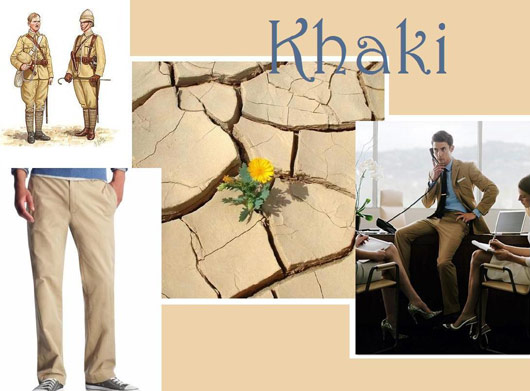
Khaki was never manufactured to stand out. It comes from an Indian word meaning “dust coloured”; fabrics in this shade were first produced as camouflage for the British Indian Army regiments by a British textile firm in the 1870s. The colour of light clay, the Brits found that khaki was extraordinarily useful and variations on the colour and the textile it was dyed on still exist in the forces today. Khaki drill played its part in the Boer War, the Spanish American war and both World Wars and is usually the first thing anyone thinks of when you utter the words ‘El Alamein.’
It is perhaps appropriate that khaki is considered to be the first ‘practical’ colouring for the modern army. When it was used in southern Africa, the Zulu wars that had ended a decade before had seen scarlet tunics with brass buttons and Pickelhaube style white pith helmets with gold chinchains and shining capstars – acceptable for the Battlefield of Waterloo but completely outdated in world of modern warfare. Blending into the background had become not only a strategy but a priority.
Suitably, the modern ‘khaki’ trouser is the premier choice for the gentleman ill-inclined to fuss or show-off with his clothing. As the Tommies in Tobruk were indistinguishable from the landscape, so is the weekend shopper at Wal Mart. While it bounces in and out of trend, it never scoops up much attention. The man who shies away from the world rests his eyes on a pair happily as he traverses the terrifyingly open terrain of the local clothing store. Where casual clothing is concerned, khaki is always a safe choice, a refuge; social camouflage.
However, khaki trousers should be the start, and not the end, of an ensemble. Popularly paired with white or blue polo shirts and white trainers (eurgh), khaki trousers are capable of a great deal more; pink shirts, blue blazers, suede shoes, the list is endless.
The other problem is that they are commonly worn baggily and saggily, weighed down by wallets, coins, phones and small guide books; no matter what a man wears, denim or Dormeuil, he should always strive to maintain a good silhouette.
And while they are certainly appropriate for casual wear, they are not unheard of at formal functions; I remember an American gentleman at a summer wedding I once attended, quite the most elegant man there, in a navy blazer, blue end-on-end shirt, Madras bow tie, spectators and khaki chinos. The bow tie and blazer were a nod to formality, the spectators added the fun and the khakis added a cool, contrasting masculinity.
